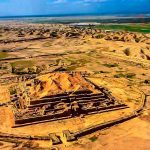The reasons for the unexpected rise and fall of the Burnt City are still wrapped in mystery. Artifacts recovered from the city demonstrate a peculiar incongruity with nearby civilizations of the time and it has been speculated that Shahr-e-Sukhteh might ultimately provide concrete evidence of a civilization east of prehistoric Persia that was independent of ancient Mesopotamia.
Archaeology
Covering an area of 151 hectares, Shahr-e Sukhteh was one of the world’s largest cities at the dawn of the urban era. In the western part of the site is a vast graveyard, measuring 25 ha. It contains between 25,000 and 40,000 ancient graves.
The settlement appeared around 3200 BCE. The city had four stages of civilization and was burnt down three times before being abandoned in 1800 BCE.
Most of the material discovered is dated to the period of c. 2700-2300 BCE. The discoveries indicate that the city was a hub of trading routes that connected Mesopotamia and Iran with the Central Asian and Indian civilizations, and as far away as China.
- Opens at: 07:30 – 20:00
- Entrance fee: 200,000 IRR
- Costume: no limit













